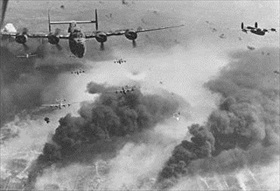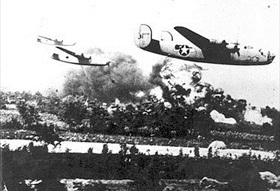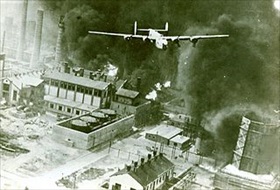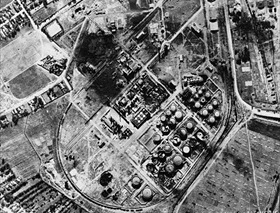U.S. OPERATION TIDAL WAVE A STRATEGIC FAILURE
Ploesti (Ploiești), Romania • August 1, 1943
Allied war planners had long favored a second, much more damaging air strike on the Ploesti (Ploiești) oil complex, the center of Romania’s natural oil industry some 35 miles north of the capital, Bucharest. In mid-June 1942, 13 U.S. B‑24 Liberators lifted off from a British airfield in Egypt, crossed the Mediterranean and Black Seas, and attacked Ploesti’s oil installations for the first time. The first-ever American bombing mission over Europe encountered minimal resistance and caused only minor damage to just one oil installation.
Tied by treaty with Nazi Germany and Fascist Italy, Romania provided anywhere from 30 or 35 percent to 60 percent of the petroleum requirements of the Axis war machine—a million tons or more of oil a month. (The failure of Germany’s 1942 offensive to capture Soviet oil fields in the Caucasus boosted the importance of Ploesti.) After the June 1942 U.S. pinprick raid the Germans turned Ploesti’s dozen oil refineries, which spread over an area six miles in diameter, into a fortress ringed by fast-firing antiaircraft cannon and machine guns. Fifty thousand Wehrmacht (armed services) personal manned the fortress’s defenses. Moreover, the Luftwaffe had dozens of Messerschmitt Bf 109 and Bf 110 fighters stationed at nearby airfields, adding to a slew of Romanian IAR‑80 fighter aircraft. An early warning antiaircraft system stretched south and southeast from Ploesti to Axis-occupied Greece and Yugoslavia.
On this date, August 1, 1943, just after dawn 177 B‑24s carrying 1,725 airmen from the U.S. Ninth and Eighth Air Forces took off from runways near Benghazi, Libya, flew north across the Mediterranean and Adriatic seas and then northeast over Albania and Yugoslavia. The Wehrmacht duly noted the heavy bombers’ intrusion as cloud cover and strict radio silence disrupted the Allies’ plan of all five air groups attacking their targets simultaneously. A wrong turn by the two leading groups toward Bucharest further complicated the mission to Ploesti. The remaining three groups roared headlong toward Ploesti, now at full alert, at 50 ft off the ground, hoping to avoid radar and antiaircraft fire but still managed to run into a metal curtain. B‑24s were turned into torches by ack-ack fire that raked their wing and bomb bay fuel tanks. Liberators managed to drop their payloads of high-explosive (HE) and incendiary bombs onto petroleum storage tanks, exploding their contents into volcanic sheets of fire and greasy smoke that concealed balloon cables and towering cracking chimneys. Red-hot tops of storage tanks flipped into the air as though they were part of a bizarre coin toss. Bombers that escaped the smoldering conflagration were set upon by waves of Axis fighters.
The intrepid airmen who took part in Operation Tidal Wave took a terrible beating. Forty-four Liberators of the 178 that left Benghazi were shot down, and 58 were badly damaged. Only 88 of the original 160 Liberators that reached their seven targets succeeded in returning to their Libyan bases. Overall losses—dead, wounded, captured, or interned by neutral Turkey (78)—came to 660 fliers out of the 1,725 who started the mission. It was the second-worst loss of men and aircraft ever suffered by the U.S. Army Air Forces on a single mission. Worst of all, the overall damage to the Ploesti refinery complex turned out to be minor. Some of the targeted refineries were largely untouched, and others that sustained damage to powerhouses, boiler houses, stills, cracking towers, pumping stations, and pipelines were repaired within weeks, after which the net output of Ploesti’s refineries was greater than ever.
![]()
Deadly Tidal Wave: The U.S. Air Raid on the Ploesti (Ploiești) Oil Complex, August 1, 1943
 |  |
Left: Early Sunday morning, August 1, 1943, five bomber groups—178 B‑24s carrying 1,780 flyers—comprising Operation Tidal Wave lifted off from airfields around Benghazi, Libya, for the 2,700 mile round trip to Ploesti, a city of 100,000 inhabitants. Ringing Ploesti were close to a dozen oil refineries that provided a reliable third or more of the petroleum that fueled German aircraft, tanks, battleships, and U‑boats. Ploesti was the “taproot of German might,” said British Prime Minister Winston Churchill. Estimated to shorten the war by six months if successful, the epic August 1 air raid—the biggest staged to date—turned out to be one of the costliest for the U.S. Eighth (transferred from England) and Ninth Air Forces. For several Eighth Air Force B‑24 squadrons, fresh from flight school in the United States, the August attack would be their first and last combat mission. In this photo a half-dozen huge four-engine, easy-to-hit B‑24Ds muscle their way through Ploesti’s extensive air defense arrays.
![]()
Right: By the time the U.S. air armada had crossed into Romanian air space, Ploesti’s air defenses were coming to full alert. They included several hundred 88mm (3.46‑in) and 105mm (4.1‑in) antiaircraft guns. Many more small-caliber guns were concealed in barns, haystacks, railroad cars, and mock buildings. In addition the Luftwaffe had three fighter groups within flight range of Ploesti assisted by some Romanian fighter aircraft. On top of these dangers, balloon cables, tall cracking towers, raging oil fires, heavy acrid smoke, secondary explosions, and delayed-fuse bombs from the strikes of the lead bomb groups increased the risks facing succeeding waves of B‑24s flying 230–250 miles per hour at tree-top level, an unprecedented employment of heavy bombers. Many pilots, choosing to skip-bomb their 500- and 1,000-pounders into their targets, flew so close to the ground that cornstalks or sunflowers were later found stuck in the bomb bays or on the bottom antennas of their aircraft.
 |  |
Left: This iconic image, one of the most famous of World War II, shows The Sandman, piloted by Robert Sternfels, as it emerges from a pall of smoke, barely clearing the stacks of Astra Romana refinery, the largest in Europe and the primary target of the Ploesti raid. The refinery suffered 50 percent destruction and took the heaviest toll on the raiders: 13 brought down by flak and 4 by fighter aircraft. Scarcely 27 minutes after the raid had begun, the last bombs were dropped by the 160 B‑24s that had reached Ploesti. The surviving B‑24s fled west with all the speed they could muster, trying to form up as best as they could for the long return flight to Libya. Only 88 out of the original 178 B‑24s made it back, and of these 55 were battle damaged by heavy antiaircraft defenses and Axis fighter aircraft. August 1, 1943, was later referred to as “Black Sunday.” Some B‑24s were forced to ditch in the Mediterranean Sea. Eight landed in neutral Turkey, while 23 were diverted to airfields on Malta, Sicily, and Cyprus. Three hundred and ten airmen were killed, some hitting the ground before their parachutes could open. (Mission planners had projected a casualty rate upwards of 50 percent.) After crash landing in Romania, another 108 flyers became prisoners of war, of which 70 were wounded. The 78 who landed in Turkey were interned. Back in Romania, 116 civilians and military personnel perished and 200 were injured in the raid.
![]()
Right: Columbia Aquila refinery after the air raid, bomb-cratered but largely intact, was out of service for eleven months. Two refineries Creditul Minier and Steaua Romana, stayed out for the duration of the war at a cost of six B‑24s and their crew. That said, an overall appraisal of the bomb damage at Ploesti indicated no long-term curtailment of overall production output, only a drastic reduction in storage capacity. Much of the observed smoke and flames came from burning storage tanks that held finished products, not from the destruction of cracking towers, steam plants, and critical pipeline junctures. Given the large and unbalanced loss of aircraft and crewmen and the limited damage to the complexes, Operation Tidal Wave was deemed a strategic failure. However, when the Red Army captured Ploesti thirteen months later, on August 30, 1944, the Soviets reported that the refineries were idle and ruined thanks to continued U.S. bombing raids.
Turning Off the Ploesti Oil Spigot: The Allied Bombing Campaign Against Romania’s Oil Complex
![]()

 History buffs, there is good news! The Daily Chronicles of World War II is now available as an ebook for $4.99 on Amazon.com. Containing a year’s worth of dated entries from this website, the ebook brings the story of this tumultuous era to life in a compelling, authoritative, and succinct manner. Featuring inventive navigation aids, the ebook enables readers to instantly move forward or backward by month and date to different dated entries. Simple and elegant! Click
History buffs, there is good news! The Daily Chronicles of World War II is now available as an ebook for $4.99 on Amazon.com. Containing a year’s worth of dated entries from this website, the ebook brings the story of this tumultuous era to life in a compelling, authoritative, and succinct manner. Featuring inventive navigation aids, the ebook enables readers to instantly move forward or backward by month and date to different dated entries. Simple and elegant! Click 











